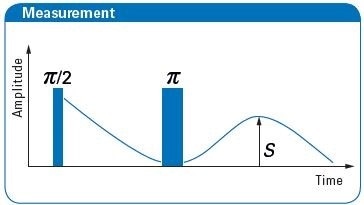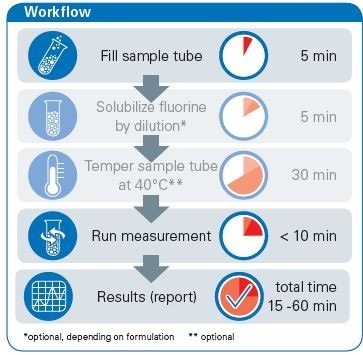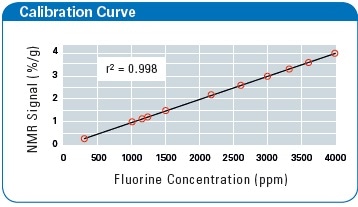
Many ingredients are added to mouthwash and toothpaste to improve both health benefits and quality. Fluorine is one such ingredient that is added to these items to strengthen tooth enamel and thus prevent cavities. This chemical element is typically added in the amounts of 1000 to 1500 ppm.
Sodium fluoride (NaF), sodium monofluorophosphate (Na2PO3F), and stannous fluoride (SnF2) are some of the active ingredients used. Apart from fluoride, other ingredients can also be included to obtain abrasiveness (silica) or whitening effects (peroxide).
It is important to accurately control the fluorine content. While a minimum amount of 1000 ppm is required to provide the preferred benefit of strengthening tooth enamel, excess amounts of fluorine are associated with health risks, such as dental fluorosis.
Regardless of the toothpaste matrix and fluorine compound, the fluorine content in the toothpaste can now be accurately determined using Time Domain Nuclear Magnetic Resonance (TD-NMR). TD-NMR analysis is both fast and simple, making it the preferred method for product development, production¸ and quality control.
Features and benefits
The following are the key features and benefits of the TD-NMR analysis:
- Most cost-effective at-line fluorine content determination
- Broadly applicable for many different toothpaste formulations
- Automation option
- Measurement time takes less than 10 minutes
Application method
The TD-NMR analysis is built on the linear and quantitative signal response from the fluorine nuclei present in the sample. Hence, the NMR signal S (Hahn-Echo) amplitude is in direct proportion to the soluble fluorine mass.

Image Credit: Bruker BioSpin Group
Note: Only soluble fluorine is detected due to the very fast signal decay of immobilized or insoluble fluorine, for example in calcium fluoride (CaF2) or magnesium fluoride (MgF2). The soluble fluorine contributes to the desired health benefit.

Image Credit: Bruker BioSpin Group
Calibration procedure
- Linear correlation with r² > 0.995
- Calibration range: 250 to 4000 ppm fluorine content
- Coefficient of variance (CV) is less than 3% for repeated measurements of a 1000 ppm sample

Image Credit: Bruker BioSpin Group
It must be remembered that only soluble fluorine can be detected owing to the rapid signal decay of insoluble or immobilized fluorine, for instance in magnesium fluoride (MgF2) or calcium fluoride (CaF2). The desired health benefit is provided by the soluble fluorine.
Three to five samples of known fluorine content are used to calibrate the method. It is recommended to use aqueous NaF solutions as calibration samples. Another option is to use solutions of other APIs. The weight-normalized NMR signals (i.e. amplitudes) obtained are associated with the fluorine content through linear regression.
Recommended equipment
- m+ software (21 CFR part 11 compliant)
- mq20 Toothpaste Analyzer
- 26 mm sample tubes
- IQ / OQ Documentation
- Precision Balance
- Option: Automatic sample changer

About Bruker BioSpin Group
The Bruker BioSpin Group designs, manufactures, and distributes advanced scientific instruments based on magnetic resonance and preclinical imaging technologies. These include our industry-leading NMR and EPR spectrometers, as well as imaging systems utilizing MRI, PET, SPECT, CT, Optical and MPI modalities. The Group also offers integrated software solutions and automation tools to support digital transformation across research and quality control environments.
Bruker BioSpin’s customers in academic, government, industrial, and pharmaceutical sectors rely on these technologies to gain detailed insights into molecular structure, dynamics, and interactions. Our solutions play a key role in structural biology, drug discovery, disease research, metabolomics, and advanced materials analysis. Recent investments in lab automation, optical imaging, and contract research services further strengthen our ability to support evolving customer needs and enable scientific innovation.
Sponsored Content Policy: News-Medical.net publishes articles and related content that may be derived from sources where we have existing commercial relationships, provided such content adds value to the core editorial ethos of News-Medical.Net which is to educate and inform site visitors interested in medical research, science, medical devices and treatments.